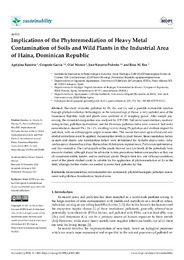Por favor, use este identificador para citar o enlazar este ítem:
https://hdl.handle.net/11000/37896Registro completo de metadatos
| Campo DC | Valor | Lengua/Idioma |
|---|---|---|
| dc.contributor.author | Ramírez, Agripina | - |
| dc.contributor.author | García, Gregorio | - |
| dc.contributor.author | Werner, Olaf | - |
| dc.contributor.author | Navarro‐Pedreño, José | - |
| dc.contributor.author | Ros, Rosa M. | - |
| dc.contributor.other | Departamentos de la UMH::Agroquímica y Medio Ambiente | es_ES |
| dc.date.accessioned | 2025-11-06T09:32:04Z | - |
| dc.date.available | 2025-11-06T09:32:04Z | - |
| dc.date.created | 2021-01-29 | - |
| dc.identifier.citation | Sustainability 2021, 13(3), 1403 | es_ES |
| dc.identifier.issn | 2071-1050 | - |
| dc.identifier.uri | https://hdl.handle.net/11000/37896 | - |
| dc.description.abstract | The study evaluates pollution by Pb, Zn, and Cr, and a possible sustainable solution through phytoremediation technologies, in the surroundings of Haina, a very polluted area of the Dominican Republic. Soils and plants were analyzed at 11 sampling points. After sample processing, the elemental composition was analyzed by ICP‐OES. Soil metal concentrations, contaminating factors, pollution load indexes, and the Nemerow pollution index were assessed. Soil metal concentrations showed Pb > Zn > Cr, resulting in very strong Pb pollution and medium‐impact Zn pollution, with an anthropogenic origin in some sites. This means that some agricultural and residential restrictions must be applied. Accumulation levels in plant tissues, bioaccumulation factors in roots and shoots, and translocation factors were determined for Acalypha alopecuroidea, Achyranthes aspera, Amaranthus dubius, Bidens pilosa, Heliotropium angiospermum, Parthenium hysterophorus, and Sida rhombifolia. The vast majority of the plants showed very low levels of the potentially toxic elements studied, although it may be advisable to take precautions before consumption as they are all considered edible, fodder, and/or medicinal plants. Despite their low rate of bioaccumulation, most of the plants studied could be suitable for the application of phytoremediation of Zn in the field, although further studies are needed to assess their potential for this. | es_ES |
| dc.format | application/pdf | es_ES |
| dc.format.extent | 26 | es_ES |
| dc.language.iso | eng | es_ES |
| dc.publisher | MDPI | es_ES |
| dc.rights | info:eu-repo/semantics/openAccess | es_ES |
| dc.rights | Attribution-NonCommercial-NoDerivatives 4.0 Internacional | * |
| dc.rights.uri | http://creativecommons.org/licenses/by-nc-nd/4.0/ | * |
| dc.subject | bioaccumulation | es_ES |
| dc.subject | environmental risk assessment | es_ES |
| dc.subject | phytotechnologies | es_ES |
| dc.subject | pollution assessment | es_ES |
| dc.subject | soil pollution | es_ES |
| dc.subject | translocation | es_ES |
| dc.subject | tropical areas | es_ES |
| dc.subject.other | CDU::5 - Ciencias puras y naturales | es_ES |
| dc.title | Implications of the Phytoremediation of Heavy Metal Contamination of Soils and Wild Plants in the Industrial Area of Haina, Dominican Republic | es_ES |
| dc.type | info:eu-repo/semantics/article | es_ES |
| dc.relation.publisherversion | https://doi.org/10.3390/su13031403 | es_ES |

Ver/Abrir:
31_sustainability-13-01403.pdf
1,44 MB
Adobe PDF
Compartir:
 La licencia se describe como: Atribución-NonComercial-NoDerivada 4.0 Internacional.
La licencia se describe como: Atribución-NonComercial-NoDerivada 4.0 Internacional.
.png)